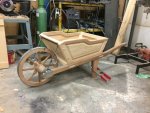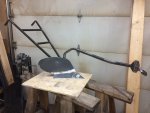BLO is safe to use, as long as you pay respect to not leaving the BLO soaked oily rags in the shop when you finish applying it. Actually, there are other "drying oils" on the market that you should also be very careful when using. Some of these are Dainish oils and Tung oils or variations of them, of which many of these products are actually blends that contain BLO and driers. When you use any of these "drying oils" you should be equally as careful with the rags when you finish using them. The chemical action of the drying process absorbs oxygen from the air and generates heat. This heat will build up rapidly in a bunched up rag, because it does not get free air flow to remove the heat.
Before moving here I was opening up my oily rags and draping them over my neighbor's chain link fence next to my shop where they wouldn't easily be seen, so they would dry without over heating. After two days they would be completely dry and I would throw them away in the trash. Here, next to my shop I have a 5 gallon galvanized trash can with a tight fitting lid. I put several gallons of water in it, and put my drying oil soaked rags into this water and replace the lid. After several days, or whenever I think of it, I wring out the rags and throw them in the trash. By then the water has fully interrupted the chemical reaction and the rags are safe to throw away.
I use BLO often, because a coat of it on figured wood makes the grain really pop in appearance. Then I follow this coat with other finishes, but I make certain that I get the oil soaked rags out of the shop and into a pail of water as soon as I finish using them. I have a lot of respect for fire, and was a volunteer fireman for most of my working life. At 77 I'm now fully retired from a daily job as well as the fire service. My woodworking and photography hobbies keep me active now. I still sometimes respond to fires, but it's with my camera now.
Charley




